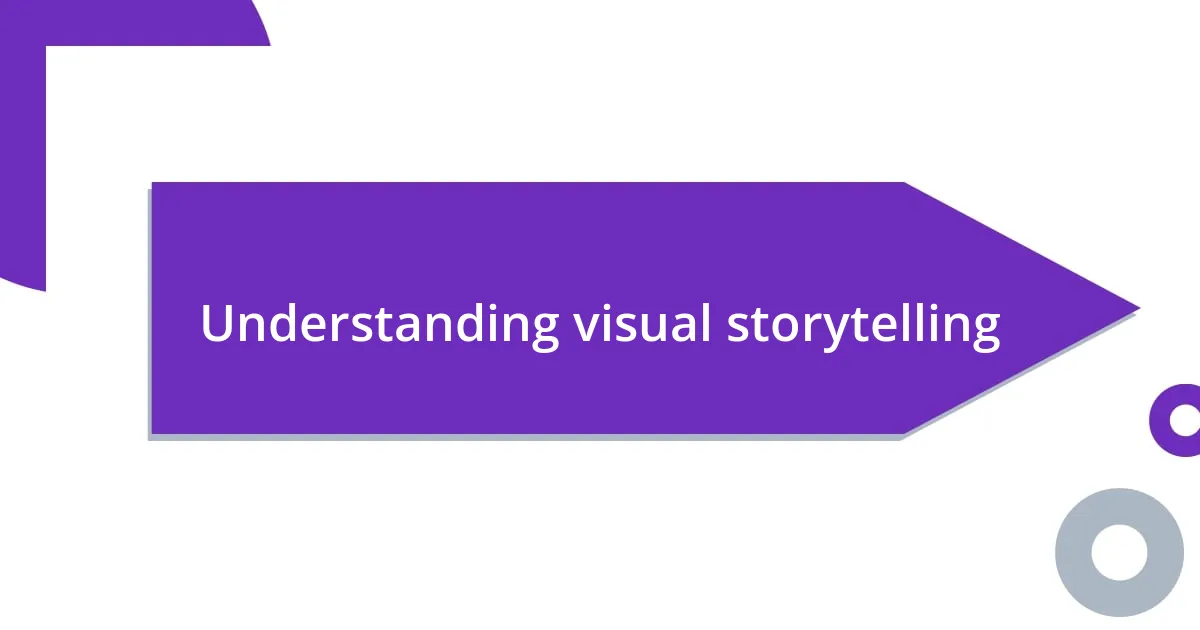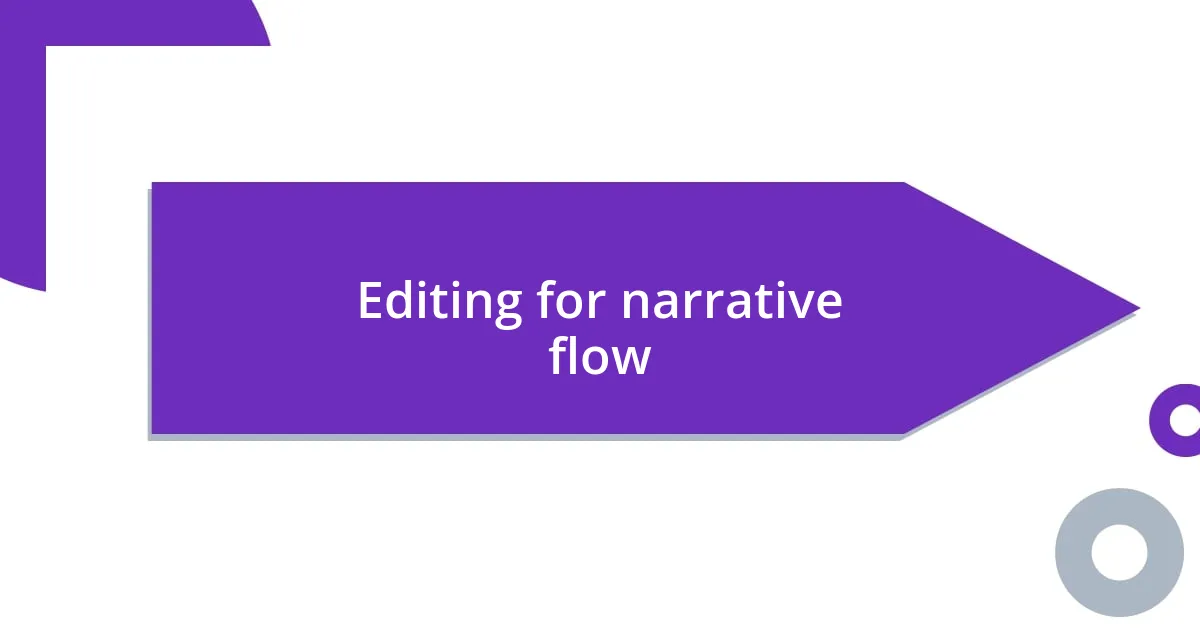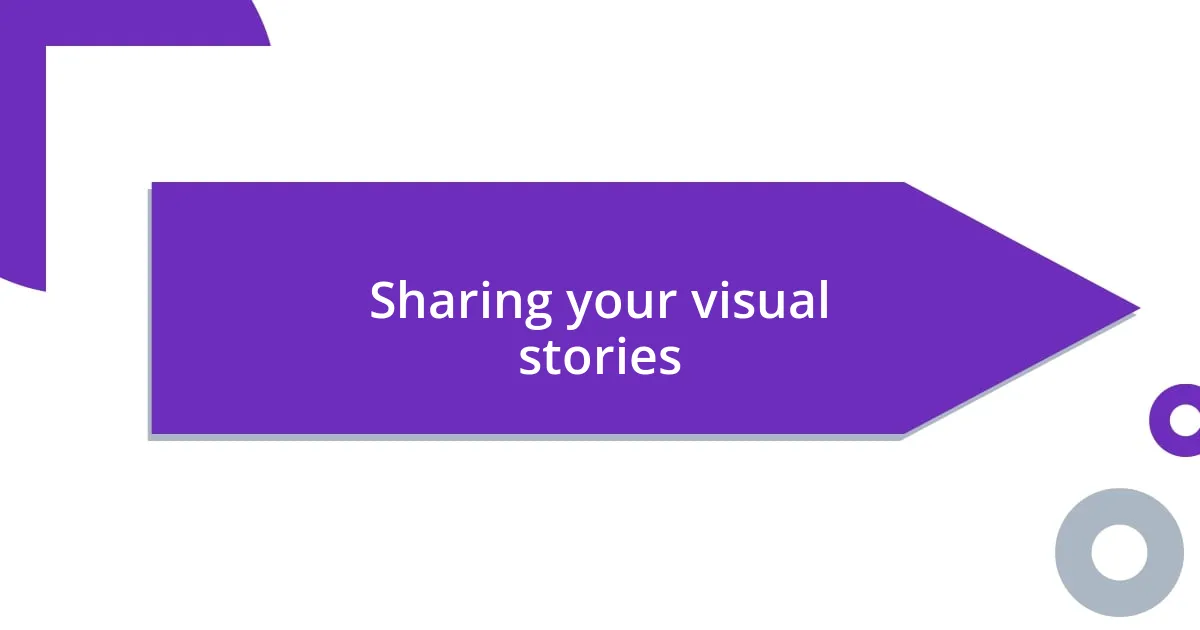Key takeaways:
- Visual storytelling uses elements like composition, color, and light to evoke emotions and narratives.
- Identifying the story concept is essential, focusing on emotions, audience, context, themes, and experimentation.
- Choosing subjects based on their emotional resonance enhances the depth and impact of the narrative.
- Editing images strategically can create a compelling narrative flow, guiding the viewer’s emotional journey.

Understanding visual storytelling
Visual storytelling is a powerful medium that transcends words, allowing emotions and narratives to unfold through imagery. I remember once capturing a moment of pure joy at a family reunion; a simple snapshot of laughter among cousins conveyed a whole story of shared memories, love, and warmth. Isn’t it fascinating how a single image can evoke a flood of feelings and connect us to experiences we may have thought were long forgotten?
When I dive into visual storytelling, I often consider the elements that breathe life into an image—composition, color, and light. For instance, a photograph taken during the golden hour can create a sense of nostalgia and ethereality that a stark midday shot might lack. Have you ever noticed how a carefully chosen palette can shift your emotional response entirely? It’s incredible how these details work together to guide viewer interpretation.
I also think about the journey of the viewer. Each person brings their own experiences and emotions to the table, which colors their perception of the story being told. Just the other week, I shared a travel photo of a bustling market with vibrant colors and rich textures. While I saw it as a celebration of culture and vibrancy, a friend remarked on the chaotic energy, reminding me how varied our interpretations can be. Isn’t it interesting how one image can have so many narratives intertwined within it?

Identifying your story concept
Identifying your story concept is the foundational step in my process for visual storytelling. I believe that clarifying what you want to express or communicate is essential. For instance, I once found myself wandering through a quiet forest, capturing the serene details of nature. The simplicity of the moment sparked in me a desire to tell a tale of solitude and reflection. That experience taught me that an effective story concept often arises from personal experiences that resonate deeply.
To help crystallize your story idea, consider these key points:
- Define your emotions: What’s the core feeling you wish to convey? Reflecting on my emotions during that forest walk guided my photography choices.
- Recognize your audience: Who do you want to reach, and what do you want them to feel? Understanding the viewer’s perspective can shape how you frame your images.
- Establish context: Think about the setting and background that will support your narrative. Those elements can significantly enhance the story.
- Focus on a theme: Whether it’s love, adventure, or loss, having a central theme can unify your imagery.
- Experiment with ideas: Sometimes, I jot down words or phrases that inspire me; it helps unlock ideas that transform into visual stories.
These considerations allow me to hone in on the essence of the story I wish to tell—setting the stage for compelling imagery.

Choosing the right subjects
Choosing the right subjects is a pivotal part of my visual storytelling. It’s fascinating how the subject can either make or break the narrative you wish to convey. Once, while traveling through a quaint village, I stumbled upon an elderly man tending to his garden. His weathered hands cradled vibrant flowers, and in that moment, I felt a profound connection to resilience and nurturing. Choosing him as my subject transformed a simple photo into a heartfelt portrayal of life’s delicate beauty.
I often evaluate my subjects based on their emotional resonance and the stories they carry. Take a candid shot of a child laughing, for example. It sparks joy and reminds us of innocence, while a portrait of a weary traveler can evoke feelings of longing and adventure. I remember capturing a street musician lost in a soulful melody. The depth of his expression told stories of struggle and passion, captivating viewers and inviting them into his world. This highlights how select subjects can deepen the emotional impact of a photograph.
When considering the right subjects, I find it beneficial to think about their environment and relationships. A bustling café captures the lively spirit of community, while an empty street at dusk invites contemplation. Recently, I noticed a mother and child sharing a quiet moment on a park bench. The surroundings—fluttering leaves and soft sunlight—perfectly complemented the tenderness of their connection. By focusing on subjects that reflect the emotion or theme I want to convey, I enrich my narratives and invite viewers to feel what I felt.
| Subject Type | Emotional Impact |
|---|---|
| Candid Humor | Joy and Innocence |
| Introspective Portraits | Longing and Depth |
| Emotive Environments | Contemplation and Connection |

Composing effective images
Composing effective images requires a keen understanding of not just what you’re photographing, but why you’re photographing it. I recall a rainy day when I decided to capture the mood of solitude. Instead of bustling streets, I chose a lone umbrella resting against a brick wall, droplets glistening like tiny diamonds. The simplicity of that scene told a story without the need for people, illustrating how sometimes less truly is more.
Lighting plays a crucial role in the composition of my images. I often experiment with natural light, as I’ve discovered that it can transform the same subject completely. For instance, I once shot a simple bouquet in harsh midday sunlight, and it fell flat. However, when I waited until the golden hour, the soft light wrapped around the flowers, creating a warm, inviting glow that breathed life into the photograph. Isn’t it fascinating how a shift in light can alter the emotional tone of an image?
Framing is another key component I always consider. I engage with the scene by looking for natural frames—like branches or doorways—that can lead the viewer’s eye and create depth. That reminds me of the time I used an archway to frame a couple sharing a quiet moment in a bustling park. The arch became a visual portal, contrasting the chaos outside and emphasizing their intimacy. Isn’t it intriguing how framing can change the perception of a moment, inviting viewers to step into the story I’m telling through my lens?

Utilizing light and color
Utilizing light and color can profoundly shape the mood and narrative of my images. During one of my early photography adventures, I discovered the incredible impact of color while capturing a vibrant marketplace. The vivid reds of ripe tomatoes and the deep greens of fresh herbs created a lively tapestry that pulled me into the scene. I remember feeling like I could almost hear the laughter and chatter of vendors, showcasing how a palette can evoke not just visuals but emotions as well.
I’ve learned that light is essentially the brushstroke of photography. I once shot a serene landscape at dawn when soft pastel hues painted the sky. The combination of gentle blues and warm pinks epitomized tranquility. Reflecting on that moment, I felt a sense of peace wash over me. How often do we underestimate the power of light in conveying not just beauty, but also the very essence of what we want to portray? The right lighting doesn’t just illuminate—it narrates.
As I dive deeper into the world of photography, I also think about how color influences perception and evokes specific feelings. A striking example was when I captured an autumn scene, where golds and oranges enveloped the trees. The warm tones seemed to invite viewers into a moment filled with nostalgia and warmth, reminding them of cozy gatherings. It’s amazing how a simple shift in color can invoke memories and emotions, isn’t it? By thoughtfully utilizing light and color, I can create a compelling visual story that resonates with the audience on a deeper level.

Editing for narrative flow
Editing for narrative flow is where the magic of storytelling truly unfolds. I’ve often found that the way images are sequenced can evoke powerful emotions. For example, when I arranged a series of photos from a recent family gathering, I intentionally placed a joyful candid of my niece just before a quieter, reflective image of my grandfather. This transition created a natural ebb and flow, guiding the viewers through the contrasting emotions of celebration and nostalgia.
What I love about this process is the ability to shape a viewer’s journey. During a recent project, I vividly remember selecting images of diverse landscapes, starting with an expansive ocean view that radiated freedom and excitement, followed by a close-up of a lone seashell. This not only created a visual narrative but also prompted viewers to reflect on their own relationship with nature. Have you ever felt that rush when the sequence just clicks? It’s a little like composing music where each note builds upon the previous one, culminating in a harmonious story.
Moreover, the editing phase is when I analyze how each image contributes to the overall theme. I once compiled a series of photos representing my travels, and as I laid them out, I noticed a certain rhythm developing. The dark, moody images of cloudy skies contrasted beautifully with vibrant street scenes bursting with life. It made me realize that tension and harmony in visuals are pivotal. I often ask myself, “What story do I want to tell with this flow?” This question fuels my editing choices, allowing me to create a compelling narrative that resonates with the audience long after they’ve moved on.

Sharing your visual stories
Sharing your visual stories is a unique experience that can resonate deeply with an audience. I remember the day I posted a photo set on social media depicting my hike through a breathtaking national park. As I shared those images, comments started flooding in. People connected with the sense of wonder and adventure I captured, which made me realize how delightful it is to engage viewers through visual narratives.
When I reflect on the stories I share, I think about how an accompanying caption can transform the images. For instance, during a winter trip, I captured a simple yet stunning shot of snowflakes resting on a wooden fence. By adding a few words about the chilly air and the warmth of a cozy fire waiting at home, the picture evolved into a moment of feeling. Have you ever noticed how a single sentence can change perceptions? This is the power of words paired with visuals.
Moreover, I’ve found that choosing the right platform for sharing can amplify your story. I once decided to present a series of images from a recent community festival on a dedicated blog. The space allowed me to elaborate more on the cultural significance of each capture. I still remember the comments from readers who shared their own stories about similar experiences, showing how powerful storytelling can create a sense of connection among individuals who might never meet otherwise. Isn’t it fascinating how visual storytelling can bridge gaps and foster community?












